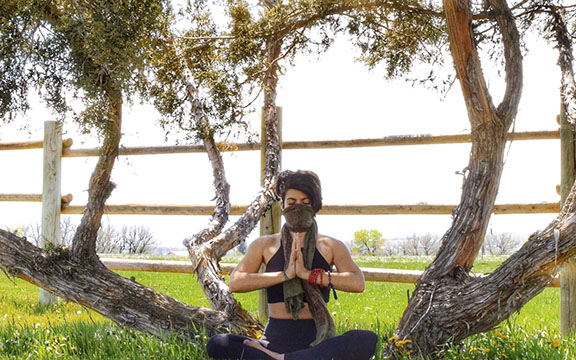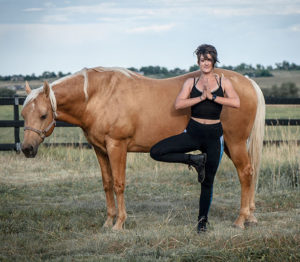 I’ve found myself feeling weird amid the COVID-19 crisis. I use this vague and understated label “weird” because I’ve yet to find a more specific adjective to properly encompass what’s happening internally.
I’ve found myself feeling weird amid the COVID-19 crisis. I use this vague and understated label “weird” because I’ve yet to find a more specific adjective to properly encompass what’s happening internally.
As a yogi, I’m supposed to be all zen during a crisis, right? Wrong. That’s why I practice Yoga. It’s my toolbox for dealing with and improving upon my inherent lack of zen.
I’ll start by saying that I’m speaking from a place of immense privilege. I have the ability to work from home and can return to my job. I’m in good health. Statistically, if I were to fall ill, I’m in a category that holds extremely high recovery rates. I have health insurance if that were to happen. While not overflowing with cash, I have the financial means to keep my fridge fully stocked for weeks at a time. I don’t have children requiring me to pick up an entirely new job of homeschooling.
All in all, my life is the best-case scenario for this kind of situation. If straight-up logic were the only thing involved in the human response, I wouldn’t be writing this.
Yet, I still feel…off. I feel scared and depressed and anxious and restless—even as I prepare to head back to work and start inching my way back to normal. Every slight inconvenience transforms into a life-altering crisis. I’m trigger happy. Why, though, when I was essentially set up for success? I have all the tools and assets needed to handle this relatively easily.
Granted, this is a difficult time of year for me. It’s a season that holds countless reminders of past traumas. There are various anniversaries of pain—deaths, birthdays, and holidays that stir up undesirable emotion. While these experiences still affect my emotional well-being, I have come to cope with them quite well over the years. Varying degrees of wellness, but well nonetheless.
Despite my best attempt to blame my general lack of chill on these things, it’s clear there’s something more going on. The past few years have not been this hard. I hadn’t dwelled on any of these memories the way I have this time around.
So then I looked to the obvious virus-ridden elephant in the room. Although I’m in as fortunate of a position as any middle-class citizen could be, it’s still a global pandemic. Even if you’re low risk, that should generate a little emotion for anyone who possesses even an iota of empathy. People are dying and struggling and losing their means to feed their families.
But again, I ask, Why such an extreme reaction? People die and struggle and lose their jobs around the world every day. So what specifically is causing this panic and strong activation of our sympathetic nervous system (the part of us responsible for our fight-or-flight response)?
The amygdala, that’s what. The amygdala is like your brain’s emergency response center. It gets all fired up and takes charge in response to any possible threat.
Possible is the key word here. Possible is the reason people like myself, coming from a place of relative security, are having a hard time thinking logically. Our brains have quite literally gone into survival mode.
This is why a lot of us are overeating during quarantine. It’s easy to blame that on boredom and universal love of snacks, but on a deeper level, your brain is ringing the emergency alarm and telling you to store fat in preparation for the worst.
The amygdala is telling the more rational parts of your brain to pump the brakes. Areas like the prefrontal cortex, which is in charge of memory, rational thinking, and decision-making no longer get a say. The hippocampus is also silenced, which helps provide context to the perceived threat. I imagine you can see how this contributes to the problem.
I heard a psychologist discussing this exact topic on a podcast almost a decade ago. He metaphorically stated that there are two fundamental mistakes a human being can make: We can think there is no tiger in the bushes when there actually is one, or we can think there is a tiger and be afraid of that bush, when in fact there’s no tiger at all. Mother nature and evolution would prefer we make that second mistake a thousand times over in order to avoid making the first mistake even once. Our ancestors were wired for negativity to ensure their survival.
Yet, we don’t face the same threats that inspired this evolutionary hardwiring of our brain. I’m not going to walk out of my house in Longmont and find a tiger hiding in the bushes. A mountain lion, maybe—but you get my point here. Generally speaking, we live in a society that doesn’t require the same negative outlook and hypervigilance that we once needed to survive.
While extremely simplified, this basic understanding of the brain helps shed a light on why so many of us have been feeling such fear and restlessness at this time, regardless of our individual circumstances. This likely has something to do with why we’re reaching for pizza and potato chips instead of kale in quarantine. Why our logic and rationale are taking a back seat to fear. It might even begin to explain the great toilet paper rush of 2020. A potential threat came knocking on the brain’s front door, and the amygdala did what it does best in trying to protect us: Be. Scared.
But, good news! You’re not a lost cause, forever destined to fall in line with your pre-wired negativity. Both Yoga and science have some advice on what to do from here. As Yoga and mindfulness have made their way to modern neuroscience, research has proven the benefits of the practice on the physical structure of the brain.
So how does the science of Yoga come into play regarding our brain’s response to a global pandemic? It starts with Svadhyaya, or self-study. Svadhyaya is one of the Niyamas (ethical code) in the yogic tradition.
By taking this opportunity to study our own behaviors and responses, we have the power to change them. Seriously. Our brains can and will physically change based on where we choose to focus our attention.
You may have heard the saying “neurons that fire together, wire together.” When we react to trauma—or any other human experience—in a certain way, synaptic connections are made in the brain. The more frequently we repeat these same reactions and, in turn, repeat the same synaptic connections, the more lasting the effect on the brain and the way it functions.
People who have a strong meditation or mindfulness practice develop a thicker insula, the part of the brain associated with self-awareness and empathy. It increases the synaptic connections and blood flow there, making that person more capable of relating to and understanding their own emotions and the emotions of others. On the flip side, those who frequently react to experiences with anger and aggression are increasing the synaptic connections in the amygdala, that part of our brain creating the pandemic panic.
Let’s be clear: those rooted in empathy and self-awareness will still feel emotional pain. It’s safe to say they feel more pain. Particularly in this specific situation, empathy is painful. We are feeling the collective trauma of the world. However, pain that is generated from awareness and empathy is softer and more constructive than pain rooted in unexplained fear, stress, or anger. I’ll take the former over the latter any day.
Now, if you know me, it would be natural to ask, “But Chelsea, you’ve had a Yoga practice for years. Why then are you so affected if the practice is supposed to help the brain react differently?”
Because I’m human, as we all are. We all have these parts of our brains pre-wired to do their jobs. Also, because it’s called a Yoga practice. This work will never be done.
That’s where the Svadhyaya comes in. I’m sure I’m not the only one out there who needs to do some self-study on how I’m reacting to this situation and, quite frankly, most other stressful situations I encounter in life. Our evolutionary response will typically come up first, but we all have the power (with a little self-awareness) to change that slowly over time. Yoga practice.
This all sounds great, but what specifically can we do to rewire our brain as mentioned above?
First of all, acknowledge that your feelings of fear or anxiety are completely normal right now. Don’t beat yourself up. Secondly, remember that your fear is typically generated by a possible threat. Yeah, I’m going to italicize that word one more time—possible. Most of our fear comes from worry about what might happen in the future. Much of our anxiety is based on things that have happened in the past. Barring extreme circumstances, we are typically safe in the present.
Cross the bridge of possible threats when you come to them, if you ever come to them. Easier said than done—of this I’m tremendously aware. However, when you do your best to remind yourself of this fact whenever possible, you’re setting yourself up for emotional success. That’s mindfulness in a nutshell. Stay present.
On a more proactive level, breathe. Not just any breath, though. The most effective breathwork for calming your nervous system is deep and slow.
On the inhale, start by breathing first into your low belly, then let it rise to your mid belly, through your rib cage, and all the way up to your collarbones. On the exhale, release the air from your upper chest, then your rib cage, down to your mid belly and finally low belly. Over-exaggerate this inflation and deflation like a continuous wave through your torso.
We all breathe without thinking about it every moment of every day. Usually our nervous system will dictate what type of breath we utilize. When the sympathetic nervous system (fight-or-flight) is engaged, we take short, shallow breaths. Our brain is literally getting our body ready for action. When our parasympathetic nervous system (rest-and-digest) is engaged, our body allows for deeper breathing so we can slow down.
By intentionally manipulating your breath, you can trick your brain into activating the parasympathetic nervous system. Again, this is a practice. You’re not going to fix all your life problems in five minutes by breathing differently. However, it should have an effect, and the more frequently you practice, the stronger that effect will be.
Our experiences, and our perceptions of them and reactions to them, are physically shaping our brains every day. That shape will, in turn, dictate the ways in which we react to future experiences.
So if you’ve been reacting to this pandemic the way I have, out of evolutionarily-driven fear, try your best to make a conscious effort to sit with this experience in a more peaceful, loving manner.
Slow down.
Even—no, especially when your brain’s emergency control center wants to take over. This should encourage our brains to shift away from our inherited negativity into something more capable of creating a compassionate, interdependent human race.
If that’s the one positive we can acquire from this situation, I think it’s a darn good one.
 About the Author:
About the Author:
Chelsea Mack’s Yoga journey stared in 2008 with a college course on meditation. Soon after, she fell in love with asana, developing her personal practice for a few years before completing a 200 hr YTT in 2012. She also completed a 50 hour Yoga Sculpt training at Sol 19 and loves sharing this unique, high energy style of Yoga that invites students to strengthen not only their bodies, but their minds. Chelsea is passionate about sharing the physical, mental and spiritual practice of Yoga with anyone who is open to it.

